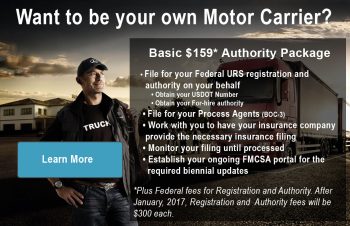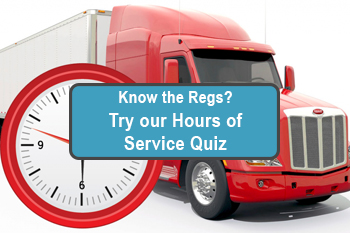
ELDs: 8 Benefits for Drivers and Owner-Operators
posted in Alerts by Brian Gray
ELDs: 8 Benefits for Drivers and Owner-Operators
Have you started your process of implementing an ELD solution for your truck or your drivers? If you haven’t, you’re either running a pre-2000 truck, you’re not aware that you’re subject to the ELD mandate (this group includes many private fleets running “medium duty” vehicles) or living in a place called “Fantasy Land,” where Part 395 is a list of suggestions and brokers give at $5.00 per mile to drivers.
Come December 18th, 2017, if you are required to keep a log book to document your hours-of-service compliance, you will need to record your hours-of-service compliance through a certified ELD (electronic logging device). If you already have an AOBRD (Automatic On Board Recording Device), then you will not need to implement an ELD until December of 2019.
Will the ELD mandate cause market consolidation and compel some drivers to hang up their keys? Yes. Although some trucking companies that always operate on the edge might be pushed out, companies that adopt and use this tool wisely should come out of the ELD mandate more competitive, even Owner Operators.
Will the Trump Administration overturn the ELD mandate? Not likely. Does the ELD mandate also offer opportunities to drivers and fleets willing and able to utilize fully and properly an ELD solution. You bet.
The Benefits of ELDs for drivers and owner-operators
1. ELDs will (Probably) Make Working Conditions Safer for Drivers
The FMCSA’s study on an ELD’s potential to reduce crashes, as conducted by Virginia Tech, concluded that the drivers in the study using an ELD had an overall 11.7% reduction in crashes and a 5.1% reduction in preventable crashes than trucks not equipped with an ELD. In fact, the FMCSA website states ELDs could prevent 26 deaths and 562 injuries annually.
These figures have been disputed by number of organizations, especially OOIDA, where they claim that the FMCSA cannot identify a casual link between ELD adoption and crash reduction, but only a correlation. Moreover, OOIDA also said that the study sample was not large enough to be representative as to how ELD implementation would or would not decrease crash figures nationwide for commercial motor vehicles.
What is indisputable, however, is that non-compliance with Part 395 will be more difficult to conceal from inspectors and auditors. As a result, compliance with the current hours-of-service rules will increase, which hopefully will also lead to less fatigued driving and therefore less crashes.
The FMCSA believes ELDs can keep regulators abreast of non-compliant drivers and prevent fatigued drivers from breaking HOS guidelines, thereby jeopardizing their personal safety as well as the safety of others sharing the road.
2. ELDs Can Simplify and Improve Documentation Requirements
 Drivers and owner-operators are responsible for recording and retaining a great deal of information to file for, and prove, their IFTA and IRP liabilities. The documents associated with IFTA and IRP include, but are not limited to: state mile reports, trip reports, fuel receipts, bills of lading or work orders, hours of service logs, weight receipts, etc.
Drivers and owner-operators are responsible for recording and retaining a great deal of information to file for, and prove, their IFTA and IRP liabilities. The documents associated with IFTA and IRP include, but are not limited to: state mile reports, trip reports, fuel receipts, bills of lading or work orders, hours of service logs, weight receipts, etc.
While filing your quarterly IFTA report or annually renewing your IRP account may not take up a great deal of time (maybe it does for you!), keeping track of all of these documents and verifying their data can take a significant amount of time. If you’re not auditing these documents on a monthly, or at least quarterly basis, you may be filing with inaccurate information.
ELDs may help to eliminate or greatly reduce the risk of inaccurate filings by automatically recording for you how many miles you’ve driven over a month or a quarter and how many miles you’ve traveled in a given jurisdiction. According to the FMCSA, drivers might save $708.00 per year in time currently spent on administrative tasks rather than on driving.
However, one needs to be aware that the purchase of an ELD does not necessarily mean it will be compliant for IFTA and IRP purposes or vice versa. IFTA and IRP each allow the use of electronic devices to document vehicle distance by jurisdiction provided the required supporting data are maintained for audit purposes. Beware of vendors stating that their systems are IFTA or IRP certified. For more information, click here to download our ebook: Differences and similarities between an ELD and IFTA/IRP compliant data recording systems.
3. ELDs can help with driver pay, per diem tracking, and documenting detention
For fleet drivers, ELDs should accurately record every mile and report back to fleet managers in real time. This can mean no more compiling mileage reports and faster payment processing. It also means drivers can have confidence that they are being paid exactly what they should be.
Additionally, having precise GPS data means that carriers now have a mechanism to accurately prove and then charge for detention time. Charging for detention time can add to a drivers overall compensation.
For owner-operators claiming per-diem dollars from the IRS, precise GPS data can help make it easier to track and provide proof to the IRS for per diem dollars claimed on their income tax filing for out on the road trips.
4. ELDs Can Help Validate What Actually Occurred on the road


5. ELDs should increase drive time, which means more miles and more money
ELD(s) should increase the amount of drive-time available to drivers. Using paper longs, drivers generally record their duty-status changes in at least 15-minute increments and as a result leave “money on the table” by recording a ten minute bathroom (off-duty) break as a fifteen minute break.
When status changes can be recorded in real-time, the driver will typically gain one to two more hours of drive-time each week.
Additionally, ELD telematics can help maximize drive time by keeping vehicles in optimal working condition. By sharing real-time vehicle health information, such as tire pressure, fault code data, DVIRs, engine diagnostics, etc, fleet managers can help prevent blowouts and unplanned service calls. As we all know, more drive time means more miles which leads to more money.
6. ELD(s) can Help Prevent and Reduce Maintenance Downtime
Many ELD(s) provide fleet managers and owner-operators with the ability to more accurately monitor vehicle maintenance, going well beyond simply providing an electronic DVIR.
As an ELD unit records the mileage or engine hours for a given vehicle, the administrative end of the ELD solution will correlate this mileage and engine hour data with schedules of service programmed for that truck so that both the driver and their mechanic be automatically alerted when a vehicle requires routine maintenance.
The same system of automatic notifications for maintenance items applies for defects found in daily inspections. If the driver records a defect on their electronic DVIR, their supervisor or mechanic can be automatically alerted of this event and be prepared to repair the truck when it comes back to home-base or to dispatch a service tech to fix the truck on-site if the defect puts the truck Out-Of-Service.
Both of these maintenance functions will help to reduce the incidence of missed repairs and therefore downtime due to your truck being in the shop or being stopped by an inspector.
7. ELDs will Provide Almost Perfect HOS Compliance, If You Read and Heed the Prompts


8. ELDs Should Help Prevent Financial Penalties Due to HOS Violations
According to the FMCSA’s 2014 Pocket Guide to Large Truck and Bus Statistics, HOS-related offenses are the biggest contributors toward violations and out-of-service (OOS) orders. And it’s not just large fleets receiving inspections – 1 million inspections were with “very small carriers” or fleets with 1-6 power units.
- Nearly 5% of driver inspections in 2013 led to an out-of-service order
- 7 of the top 20 violations from driver inspections were related to HOS
- 83% of OOS orders within the top 20 violations were related to HOS
- 47% of total violations within the top 20 violations were related to HOS
- 18% of the top 20 violations were general/form and manner log violations
Recordkeeping penalties can be as high as $1,100 per day and known falsification of records can earn an $11,000 fine. Being put out of service due to an HOS issue is yet another hit to an owner-operator. Beyond the fines, losing a day (or more) of driving revenue, upset customers, and hits to CSA scores mean HOS issues have serious consequences. ELD(s) can help reduce those the risk of meeting those negative outcomes.
Planning and research is key to getting the right ELD for your needs
All of these benefits will more than pay for the ELD device in the long-term. However, this highlights how important planning and research is to finding the right ELD that has the ability to do everything you want it to do for your company. We have done much of that research for you. You can see what we have found by clicking here.
choosing an eld drivers ELD transition eld planning for ELDs







